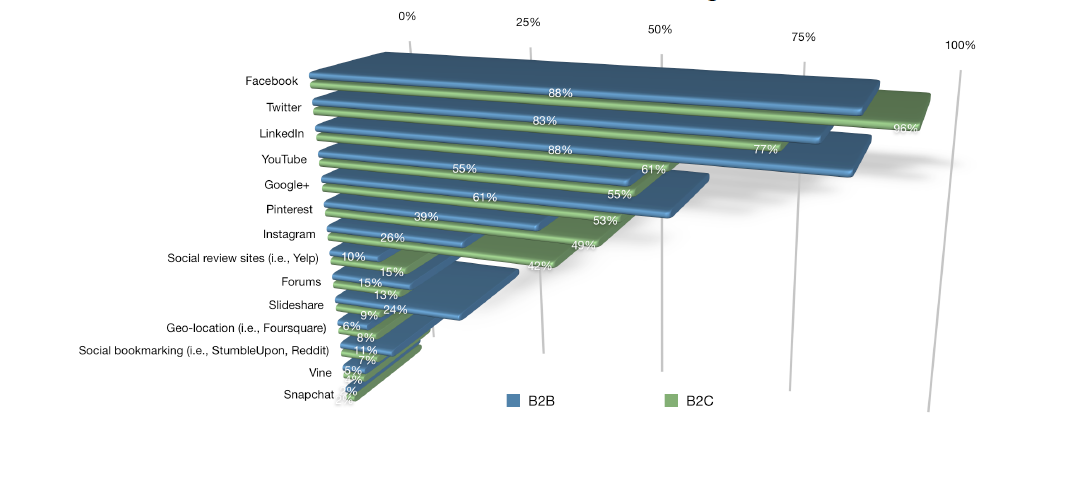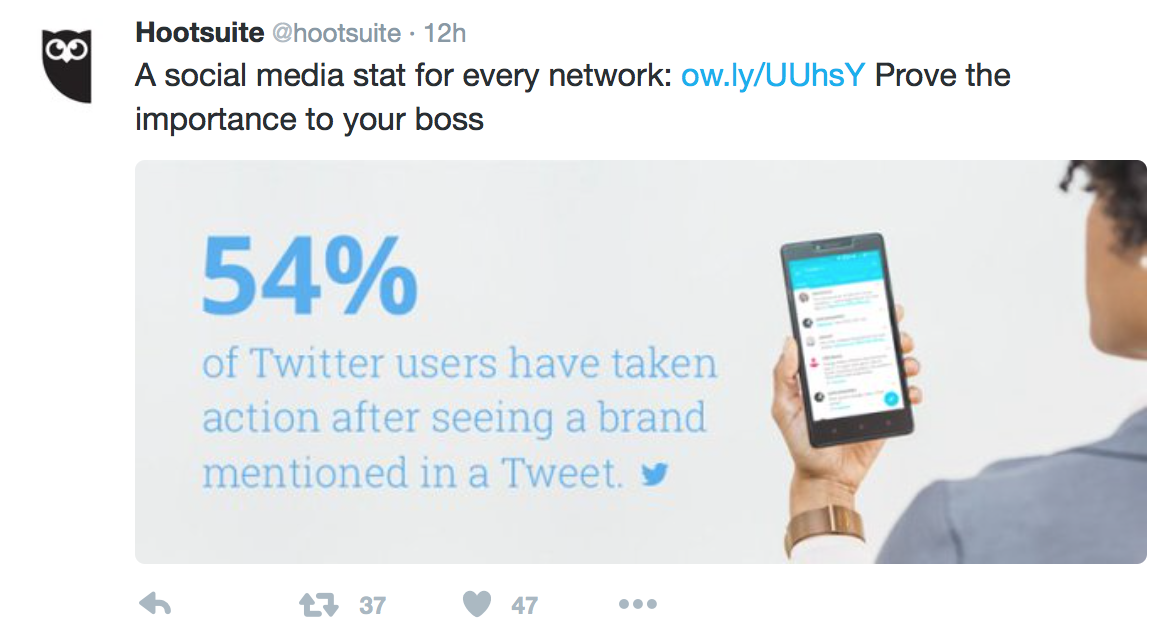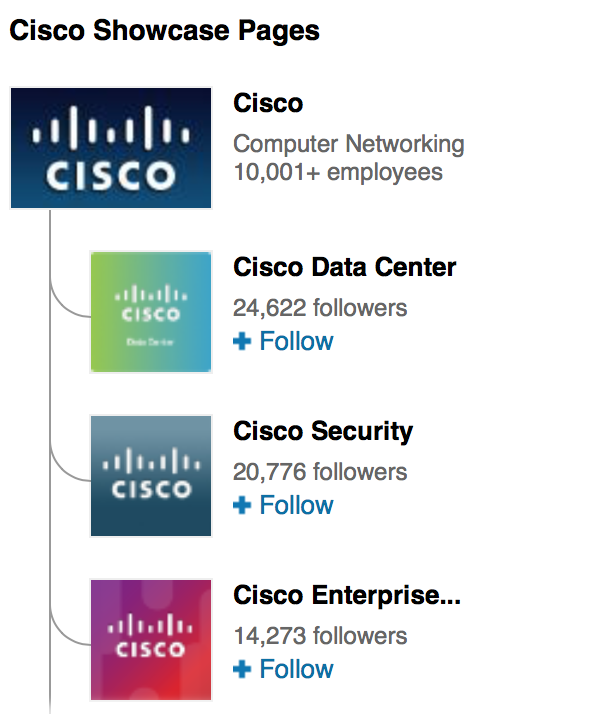It’s no secret that B2C and B2B marketing are critically different. In B2C marketing, the process for managing the content lifecycle is built around driving a single consumer to a quick, impulse purchase. But in B2B, marketers must address multiple stakeholders, each needing specific information and proof of value across a lengthy buyer’s journey.
It’s not that there aren’t any similarities between B2B and B2C, but many of the tactics at play differ—including how to engage buyers on social media channels. The differences between B2C and B2B social media marketing start with their platforms they use, their voices, and the types of content they utilize.
Platforms
The purpose of social media is to connect people with each other and to stories. When looking into platforms, it’s important to understand who is connecting on a specific platform, and for what reason.
For B2B marketing, it’s especially important to get into the mindset of your target audience so you can authentically share your company’s story across each channel to drive traffic and build brand awareness.
The major social media platforms we’re going to cover are:
- YouTube
Social Media Examiner recently did a study comparing the social media platforms currently used by marketers, and the results show that B2C marketers are more focused on Facebook, whereas B2B marketers are more focused on LinkedIn.

Below we will discuss the key differences for each platform.
Who: Both B2C and B2B companies can benefit from using Facebook to promote their company, but this platform is more geared toward a B2C company. As you can see in the chart above, when marketers were asked which platforms they use, Facebook held a more significant value to B2C companies.
B2B companies can use Facebook to promote the “human” side of their brand and connect with customers in a less formal way. This means that the content produced on your Facebook page should mainly be focused on company culture in order to represent your company’s brand and image. This space provides a great place for the company to humanize itself.
When: B2C companies should be posting at least once a day. Since Facebook is their best platform, they need to make sure they’re staying up to date and keeping their fans engaged. However, this doesn’t mean post several times a day: unlike Twitter, Facebook’s timeline is much slower. It can—and will—cloud your fans’ feed.
B2B companies don’t have to put as much time into Facebook as B2C companies, but this doesn’t mean they should ignore it. Facebook is a great way to show who your brand is in order to gain and support customer trust.
Who: This platform applies to both B2B and B2C companies—both audiences actively interact on Twitter. For B2B companies, consumers go here to get a mass stream of informative articles and information.
B2C companies should be posting content that is entertaining and easy to consume. They should push out content that is lighthearted and relative to their audience. In order to engage users, B2C companies should participate in contests or tweet chats.
B2B companies should also share content that informs and educates their audience. This means reusing content already produced by the company or finding curated content to post.

Engagement is a huge part of Twitter. It’s a conversation-based platform where companies can talk to prospective clients as well as ones who are already onboarded. Companies need to make sure that they’re aware when people are talking about their company. It is vital to the company’s success on this platform to respond to direct messages and engage in conversations about the company accordingly. Furthermore, B2B companies should retweet and like posts created by their customers, industry influencers, and employees.
Content produced should include facts, links back to a blog post, and information about upcoming events or product releases and updates.
When: Twitter’s timeline is constant and fast-paced. Because of this, tweets can get lost in the mix. So what does this mean for B2B and B2C companies? You need to post all the time. Does that mean staying up until 1 a.m. to post something about your business? The short answer is no. There are tools you can use to schedule content.
Who: LinkedIn is the largest network of professionals on a single social media platform. Therefore, it’s the perfect way for B2B companies to target their audience and deliver relevant, informative content.
To fully leverage LinkedIn, post unique pieces of content to entice readers. This is a great space to promote the educational content that your team is producing, but don’t limit yourself to that. Explore some of the other features LinkedIn has to offer, like showcase pages and industry groups.
Showcase pages are a great way to segment your company so your audience can find exactly the type of content they’re interested in, quickly. A prime example of a company using this tool well is IBM. They have IBM Cloud, IBM Security, IBM Analytics, and more. Through these showcase pages they provide content pertaining to that specific category, and have different followers according to interest.
 Another way to expand LinkedIn usage is through industry pages. Building your brand isn’t limited to your company’s page. Your leadership team’s influence also highly reflects your company, especially on LinkedIn. Your leadership should strive to become thought leaders in the industry. A great way to begin this process is by joining a LinkedIn group. By having members from your company post in industry spaces, you can start to create a name for them as well as your company.
Another way to expand LinkedIn usage is through industry pages. Building your brand isn’t limited to your company’s page. Your leadership team’s influence also highly reflects your company, especially on LinkedIn. Your leadership should strive to become thought leaders in the industry. A great way to begin this process is by joining a LinkedIn group. By having members from your company post in industry spaces, you can start to create a name for them as well as your company.
When: Because LinkedIn is a professional networking site, it stands to reason that professionals will most likely not be on it frequently during the day. The best times to post on LinkedIn is during lunch breaks or before 9 a.m.so commuters can read your content on the way to work, or after 5 p.m. as they’re catching the bus or the subway home.
Who: Instagram is geared more toward B2C, but B2B can use it to show off company culture.
B2B companies have a much longer sales cycle, and part of that cycle is gaining trust. This is where Instagram can come in handy. This platform can be a great space to show off company culture and brand values. This helps develop deeper connections with customers, which could lead to a sale.
One way to go about this is to give your followers a look behind the scenes. Did you just add a cool new space to your office? Did someone bring in their adorable new puppy? Post it! Bring the customer into your world and show them what a day in your work life is like…the fun parts, anyway.
Instagram is a space that most people use to get away from work, so show who your company is beyond that.
Another content piece that can be shared here is an event (attended or held): show where your company has been. Travel is a topic that has a great following, so use hashtags in line with that theme to feature places your company has gone.
Show the fun and exciting things your company has done in those places. Take a trip to Costa Rica for a conference? What did your employees do during their time off? Showcase someone taking a biplane through the rainforest or relaxing on the beaches: humanize your company.
Maybe take it a step further. For example, if you have an employee who’s killing it in their sport, give them a shout out. What about the employee who just wrote a novel or climbed a mountain? There are plenty of things your employees achieve outside of work that you can brag about.
Introduce your Instagram followers to people who inspire you every day: your leadership team. Highlight some of the inspiring things they’ve said to you and others in your company by quoting them for a post.
Also, introduce your Instagram followers to people who inspire you every day: your leadership team. Highlight some of the inspiring things they’ve said to you and others in your company by quoting them for a post. Motivational quotes are always an interesting thing that people love to share. Use the content you already have available and turn it into something your followers can engage with.
When: Instagram has a similar timeline to Facebook. Posting should be around once to twice a day. When a company posts multiple times a day, it begins to cloud up a user’s feed. Customers aren’t just on Instagram to follow the brands they like; they’re there to follow their friends as well. The more you post, the more likely they are to stop following your company.
YouTube
Who: B2B and B2C companies can both use YouTube to enhance their social marketing.
B2C companies have quite a few ways to take advantage of this platform, but it mostly centers around the product. Not only can you use advertisements on your company’s YouTube page, but you can also target your consumers by placing your ads before the videos you know they’re watching. Companies can also present their product through YouTube videos featuring upcoming releases, tutorials, or a celebrity demonstrating or using their product.
For B2B marketing, YouTube is a great space for educational videos. One big category is “how-to” videos. Education is a huge piece in content production for B2B companies, and educating through visual and audio content can greatly impact how much of that information is retained. Even if you host videos on your website, you can use YouTube to send out teasers and drive customers to watch the rest on your website.
Case studies are another great piece to add to your video library. Here your customer can experience firsthand the value you are providing. Another option is presenting your events. Have you attended a conference lately or held a field marketing event? YouTube can be a great place to highlight some of the things discussed in these places.
When: For B2B companies, YouTube videos should be posted about once a week. B2C companies can have a more frequent presence, especially with advertisements on other videos.
Who: This platform is B2C-centric because of the “buy it” feature and the image-based posting. However, there are a few ways B2B companies can add to the space.
Pinterest is an ideal space for B2C companies to present their products to consumers because of its shareability. For example, if someone pins a Halloween costume your company sells, next Halloween, that costume will still be relevant and someone may begin the cycle of spreading it all over again.
Another way to take advantage of this platform is to use its new “buy it” feature. Customers can now buy a product straight through Pinterest. This means easy searching for the consumer and an easy sale for the company. This platform can do a lot of work for a B2C company if they post the right products with the right tags.
B2B has less of a following on Pinterest than other networks, but the mass shareability on Pinterest can still be taken advantage of.
Infographics are one way that a B2B company can reach its audience. Because Pinterest is such an image-centric platform, infographics are a great way to push out a mass amount of easily digestible information. Posting infographics can be a great way to link back to a blog post, leading your audience back to your website. You can also “tease,” with images from a blog or other types of content that you produce on other channels. As great as it is to show off your company’s knowledge, Pinterest is highly centered on entertainment. Including a board for company culture and one for funny GIFs relating to your industry is another avenue to pursue.
When: Pins have a similar lifetime to tweets in that people have a constant stream of posts in their feed. However, unlike Twitter, feeds can get clouded by one type of content. This means you can post as often as you want, as long as the types of content you produce in a day vary.
Certain platforms tend to be more obvious choices for B2C vs. B2B companies, but that doesn’t mean you can’t take advantage of the others by thinking outside of the box!
See Where Your Content Fits Best
Still not sure how and when to use social media? Learn where content can do the most good at each level of the process through our guide to distributing your content across multiple channels.


